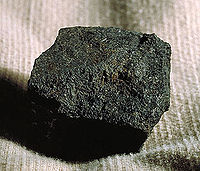
Photo from wikipedia
In order to research the evolution of energy stored in the composite coal-rock structure and coal fragments’ burst characteristics, lateral pressure unloading numerical tests of composite coal–rock models with different… Click to show full abstract
In order to research the evolution of energy stored in the composite coal-rock structure and coal fragments’ burst characteristics, lateral pressure unloading numerical tests of composite coal–rock models with different Young’s modulus were carried by PFC2D software. The research showed that the accumulated strain energy and kinetic energy in the coal was greater than that in roof and floor, and particles in the coal had a longer burst distance. The variation of the kinetic energy in the model could be separated into initialized burst, rapid burst, stable burst and residual burst stage. With the increase of the coal’s Young’s modulus, the accumulated amount and releasing velocity of strain energy in the coal decreased in the form of a power function, while the strain energy in both roof and floor changed little. The maximum value of the kinetic energy in the coal was negative linearly related to the Young’s modulus of the coal, while that of the rock was positive linearly. When the Young’s modulus of the coal was increased, particles bursted with a shorter distance, and most particles accumulated near the coal wall.